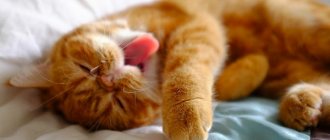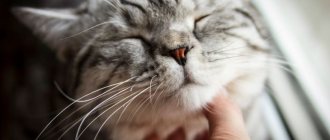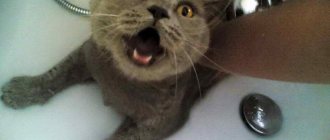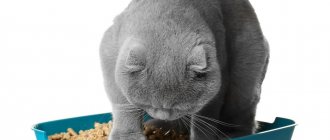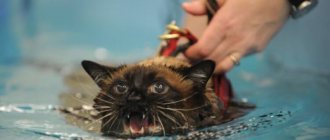If a cat falls from a height and lands unsuccessfully, then injury and bruise cannot be avoided. Of course, the health of the animal is not threatened by jumping from a cabinet, table, bed or tree. But if a cat fell out of a window from the fifth floor or even from the third, there is a high probability of fractures, concussion, and damage to internal organs. Therefore, if a cat accidentally falls from a great height and has characteristic signs of damage, it is necessary to urgently take the pet to the veterinary clinic.
What are the symptoms of serious injury after a fall?
A cat falling from a height of the 6th floor is considered more dangerous than, for example, from the 7th. The animal simply does not have time to group itself in the process and land normally. Falling from the ninth floor and above is dangerous because a fairly high speed develops, and the impact on the ground becomes stronger.
Cats love to sit on the windowsill and watch the world around them.
If an accident occurs, you need to find the animal as quickly as possible. Often owners, without noticing obvious signs, calm down and do not go to the veterinarian. However, even if the cat does not clearly show its poor condition, you should carefully monitor the animal’s behavior and pay attention to all the slightest changes.
Fractures and bruises
Most often, cats that fall from a height have bruises and fractures. Such phenomena are characterized by the following symptoms:
- With severe bruises, hematomas may appear at the site of injury; the cat does not allow the sore spot to be touched.
- Fractures are more difficult to detect - they can be open or closed. When open, the bone comes out, tearing muscle tissue and skin. Such a fracture is dangerous because infection can get into the wound. However, with prompt assistance, the risk to the animal is minimal.
- A closed fracture remains inside and cannot be immediately identified visually. A cat may have a simple crack in the bone, but without proper diagnosis and treatment, such an injury can cause negative consequences.
- A pelvic fracture is characterized by the inability to raise the hind legs.
- Damage to the limbs is noticeable if the animal is unable to lean on them and keeps them in an elevated state.
- With fractures, the limbs are unnaturally rotated, very mobile, and if there are cracks at the site of injury, an inflammatory process appears.
When palpated in the painful area, cats show aggression and try to dodge.
Cats are always trying to find some kind of loophole.
Bleeding
Bleeding can be internal or external. You should pay attention to the following symptoms:
- presence of bleeding from the nose, ears, mouth;
- the presence of serious wounds on different parts of the body;
- an enlarged abdomen indicates possible damage to internal organs and internal bleeding;
- the presence of blood in the urine indicates possible kidney damage;
- blood from the anus can also be a sign of internal organ damage.
Important! If your pet's mucous membranes become pale, it practically does not move and blood flow is noticeable, you should immediately consult a veterinarian.
Traumatic brain injuries
Head injuries are not always noticeable unless they are obvious. The cat may behave quite normally. However, if there are some signs you should be wary:
- problems with coordination, awkward movements;
- limping gait;
- lack of activity, the pet often sleeps and does not want to move;
- presence of aggression, the cat does not recognize its owners well;
- If the condition worsens, it is possible that convulsive manifestations may occur throughout the body or some parts of the body.
Brain concussion
When a concussion occurs, an animal may vomit and gait may be impaired. In most cases, after a fall from a height, the cat is lethargic and does not eat anything and sleeps constantly.
Sometimes cats can just get stuck and get hurt
Diagnosis and treatment
If a falling cat was unable to land on its feet and was seriously injured, it is necessary to urgently take it to a veterinary clinic. During the initial examination, the doctor will understand whether the animal can stand and move independently. If all the symptoms of a fracture of the spine or limbs are present, radiography is prescribed. If a concussion is suspected, an MRI is performed. If the cat does not go to the toilet for a long time, an additional ultrasound of the bladder is prescribed, since internal organs are often damaged when falling.
After confirming the diagnosis and determining the extent of damage, treatment is prescribed. If it is possible to find fractures, a plaster cast or a fixing bandage is applied. It is important to ensure that the animal moves less. For a concussion, the following groups of drugs are prescribed:
Depending on the diagnosis, certain medications are selected for the animal.
- painkillers;
- sedatives;
- normalizing cerebral circulation and pressure;
- antiemetics.
If the cat has become nervous, does not recognize the owner and is constantly trying to jump off the hands, additional consultation with a neurologist will be required. To suppress nervousness and aggression, a long course of potent sedatives is prescribed. Antibiotics may be prescribed to prevent inflammation at the site of injury. Sometimes it happens that after a fall from a great height, the animal does not pee and cannot go to the toilet for the most part. In this case, in addition to drug treatment, abdominal massage is prescribed. For successful recovery, it is important to provide your pet with physical and emotional peace.
First aid for falling from a height
What to do if a cat fell from the 3rd floor? Carefully examine the animal and go to the doctor. In most cases, this height does not pose any particular danger to cats.
Seizures in a cat: causes, what to do, treatment
If a cat fell from the 6th floor, then you need to immediately take the necessary measures and provide first aid to the injured animal. It includes several actions that should be carried out in the first couple of hours after the fall:
- First of all, you need to find the cat and examine it without touching it.
- If the animal cannot move, then you need to try to put something flat under it - a sheet of thick cardboard, plywood, the bottom of a carrier, the head needs to be fixed.
- The pet is immediately taken to a veterinary clinic or taken home, but they try to ensure peace.
- If the cat is unconscious, resuscitation is carried out - the mouth is opened, the tongue is pulled out, the nose is closed with the fingers. Then artificial respiration must be performed through gauze - air is blown into the animal’s mouth. It is important to monitor the movement of the diaphragm.
- Bandages soaked in solutions of furatsilin or chlorhexidine are applied to areas of open damage. If necessary, replace with fresh ones.
- If internal bleeding is suspected, cold compresses may be applied to the cat's abdomen and head.
Important! Arbitrary use of medications and self-treatment is not allowed. Such measures often lead to negative consequences.
After a fall, you should not move the cat intensively, try to feed or drink it, try to straighten dislocations or apply a splint, or tilt its head back.
If a kitten falls from a height, the owners do not always know what to do and are often lost. When your baby falls out, you need to see a doctor very quickly. Kittens have a less developed immune system and body as a whole; a small loss of blood will negatively affect their condition.
Prevention: what to do?
Valeria Oleinik, a veterinarian at the 911 clinic, advises closely monitoring the safety of cats, which often like to climb to heights and jump from there. Therefore, before leaving for work, do not forget to check all windows and balcony doors; for greater safety, it is recommended to install window protective nets. If a cat dies after falling from a great height, the owner does not need to blame himself, although it is not easy to survive such a loss. It is important to draw the right conclusions from the current situation and try to eliminate the factors that caused the tragedy.
What diagnostic methods are needed in a clinical setting?
The cat has a swollen paw and is limping: what to do?
In veterinary clinics, first of all, a thorough diagnosis is carried out. It allows you to identify all damage - visible and invisible - and select the most appropriate treatment. To make an accurate diagnosis, the following examinations are used:
- general blood and urine tests;
- X-ray examination of the chest to determine fractures and bruises of the ribs, lungs and other organs;
- X-ray of the spine, bones, joints, hip to exclude fractures;
- ultrasound examination of internal organs to determine the condition and presence of damage.
If necessary, the doctor will prescribe additional examinations that will help determine the cause more accurately.
If necessary, place an IV
What to do if a cat fell from a window
Why does a cat hide kittens - take them to different places and what to do
If a tragedy occurs and a cat falls from the 5th floor, the first thing to do is to go looking for it. An animal in a state of shock, if it is able to move, will try to run away and hide in a secluded place. This is what wounded animals always do.
Note! An animal that has experienced shock can be aggressive; measures must be taken against possible bites and scratches of a wounded pet.
Then the cat should be placed on a flat surface of boards, plywood, cardboard, this is done to prevent displacement of bone and spine fractures, given a sedative to drink, and the pet should be examined externally to find out visible damage.
If there are suspicions of fractures, a splint with available materials, for example, sticks, is applied to the limbs, and a pressure bandage is applied to the body. External bleeding is stopped by applying a compressive bandage above the wound.
Signs of internal bleeding
In case of loss of consciousness or vomiting, the animal should be laid on its side in the bathroom and a cold wet towel should be placed on its head. For minor injuries or mild concussions, the cat does not need the help of a specialist. Usually, after some time spent in a state of rest and proper care, his condition improves and he gets better.
Important! If there are signs of internal bleeding, pale mucous membranes, bleeding through the nose, mouth, or anus, you should immediately contact a veterinary clinic. A doctor's examination is required, even if there are no obvious signs of damage. You cannot feed the animal until its condition improves.
At your doctor's appointment, you need to tell everything about your pet's fall.
Any fall is fraught with hematomas, bruises and ruptures of internal organs, bleeding inside the body. It is not possible to detect them without the help of ultrasound and x-rays. The veterinarian must:
- restore the cat’s emotional state;
- check cardiovascular activity, since as a result of stress and shock from pain, blood pressure can sharply decrease and heart failure develop;
- examine internal organs for the degree of damage;
- examine the skeleton for fractures;
- repair external tears and scratches.
In case of large blood loss, a blood transfusion is urgently performed, and, if necessary, surgery is performed.
Note! You should not give cats painkillers, they do not bring a therapeutic effect, moreover, the drugs are very toxic, and an animal that does not feel pain can do more harm to itself. Painkillers are given only as prescribed by a doctor for complex treatment.
Cats falling from a height - treatment in the clinic
A cat came into the house as a sign: what is it for and what to do
After research and diagnosis, suitable treatment is selected. At the first stage, the cat is given special sedatives to relieve the state of shock and relieve the animal from stress. Severe nervousness leads to disruption of the functioning of all organs.
If necessary, surgery is prescribed to eliminate internal damage. In case of fractures, the bone tissue is connected and plaster is applied.
If you have a traumatic brain injury, you may need to use a ventilator.
The animal is prescribed a number of suitable medications that will help rapid recovery, and droppers with medicinal solutions are placed. The cat's condition is monitored daily.
For fractures, plaster is applied to the damaged areas
What height is considered safe for a cat?
All cats have an organ that controls the position of the head to the body, which is located in the labyrinth of the inner ear. When falling, the animal spreads its paws to the sides, thereby making something like a parachute out of its flattened body.
But it happens that domestic cats, as a result of a state of shock from a fall, cannot use their innate reflex and break. For example, the speed of a falling cat is 100 km/h, regardless of the height of the fall, while a person falls at a speed of 210 km/h. This is explained by the lightness of the animal’s skeleton, its small size, and the presence of fur.
For your information! The cat's spine has a special structure, elastic ligaments that provide greater mobility and flexibility, and the ability to turn 180°. In addition, only 16 ribs are attached to the spine, the remaining five (they are called false) have no connection with the spine.
Skeletal structure of a cat
Research by the American veterinarian G. Robins proves that a high fall height is less dangerous for the cat family than a low one. Low altitude leaves no time for turning around, and the number of injuries from falling increases. It turns out that a kitten that falls from the hands of a child is more injured than if it fell from a high-rise building. A cat falling from the 4th floor has fewer consequences than a cat falling from an open window from the 2nd floor.
Note! A falling cat seems to refract its body in the middle, with 2 parts of the body synchronously rotating around its axis, following the laws of physics with a vector equal to zero. The body does not twist, but turns over.
The head is straightened out first, followed by the back and paws. During the rotation, the cat's hind legs are moved a decent distance from the body, while the front legs are close to the head and rotate in the opposite direction. This helps her slow down her fall.
The front legs extended and the hind legs extended to the level of the body help her stop the rotation before landing. Before hitting the ground, the paws are synchronously lowered down, the back is arched.
All this was helped to see by slow-motion filming of a cat falling from different heights, carried out by the American G. MacDonald. During the experiment, the cat was thrown upside down, upon reaching the highest point, before starting to fall, it did a flip and always landed on all four paws.
Falling from a height is not dangerous for the animal
The successful landing of an animal depends on its sense organs. A deaf cat falling is no different from a healthy cat, but if the animal is blindfolded, its life-saving activity is slowed down and the risk of injury increases.
Important! The weight of the pet also affects the landing.
The lighter the cat, the less likely there is to be an injury.
Consequences
If a cat falls from the third floor or lower, then in most cases there are no serious consequences. The animal is in shock for a while and then lives a normal life.
If you jump from the sixth, seventh or higher floors, the risk of serious damage increases significantly. The consequences of a cat falling from a height are immediate and secondary.
The first group includes arrest of the respiratory process and heart, serious blood loss, and shock.
Secondary consequences arise after some time. These include inflammatory processes in internal organs, impaired functioning of the kidneys and liver, infections entering the wounded surface, and blood poisoning.
With correct and timely assistance, negative consequences rarely occur.
Important! It is necessary to quickly take your pet to the hospital to reduce the risk of developing malfunctions in the functioning of organs and systems.
Preventing cat injuries
It is not possible to avoid injuries in a domestic cat, but the owner can minimize the risks of various fractures, dislocations, wounds and concussions. To do this, it is necessary to prevent the cat from jumping from heights and not allowing free walking on the balcony. If the cat likes to stay on the balcony for a long time, you need to take care of the presence of a special mesh, as reinforced as possible.
You should not self-medicate if the owner knows that the cat fell from the roof, balcony or tree. It is important to seek professional help.
How to prevent a cat from falling out of a window
Cats love heights, so they don't feel much fear. The result is often falls and serious injuries. It is possible to protect an animal from such a situation by following safety rules:
The safety of the animal depends on the owner
- If the animal likes to sit on the windowsill, then it is recommended to take care of durable mosquito nets that can withstand serious pressure.
- Nets should also be placed on the balcony to prevent the possibility of falling from it.
- When leaving the apartment, be sure to check all the windows; in the absence of the owner, cats become even more curious.
- If your pet experiences falls from the bed, cabinets, or other places while sleeping, you should contact your veterinarian for an examination. Perhaps this is a sign of some disease.
If a cat falls from a height, then in most cases the fault lies with the owner. Inattention and absent-mindedness lead to similar consequences. The injured animal is carefully and quickly taken to the hospital for diagnosis and selection of the most appropriate treatment. Following preventive measures will help avoid accidents.
How to protect animals from injury when falling from a window?
Very often, the cause of accidents with pets is the negligence of their owners. An example is cats falling from windows. Although pets spend most of their time in the apartment, they nevertheless retain their natural instincts. They love to hunt and are practically not afraid of heights. These two factors often become fatal for them. Having seen a bird flying outside the window and not assessing the situation, cats often rush after it and, as a result, fall out. While on a windowsill (or balcony), hearing an unexpected noise or seeing a sudden movement, pets may slip and lose their balance. To avoid this, cats should not be left unattended in rooms with an open window or balcony. Also, special protective nets are required on the windows; although they are not an insurmountable obstacle for the animal, they still reduce the risk of falling out.
A little patient at the Aibolit Plus veterinary clinic
There is a myth that cats have 9 lives. It is based on the fact that they are able to emerge unscathed from the most dangerous situations. For example, a cat falling from the 7th floor can only get away with fright. Several anatomical features contribute to this. Cats lack collarbones and have a long tail, which helps them quickly assume the optimal body position when falling. They also have pads on their paws that soften the landing.
Therefore, in an “ideal” fall, when there is time to change the position of the body, and the landing site is covered with soft grass, cats often remain unharmed. But this is often not the case: trees usually grow under the windows, there are various buildings and canopies, and the crash site is a paved surface. In addition, do not forget that height plays a decisive role. If an animal falls from about the third floor, then it simply does not have enough time to optimally fix itself in flight. And if the fall comes from a height higher than the 9th floor, then no pads will protect the pet from serious consequences.

